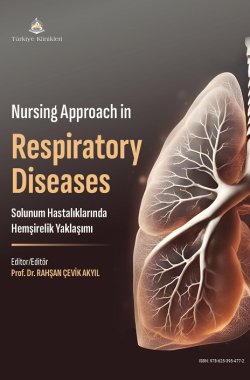Nurse Follow-up in Pulmonary Hypertension
Fikriye ERSELa , Serap ÖZERb
aEge University Atatürk Health Care Vocational School, Department of Therapy and Rehabilitation, İzmir, Türkiye
bEge University Faculty of Nursing, Department of Internal Medicine Nursing, İzmir, Türkiye
Ersel F, Özer S. Nurse follow-up in pulmonary hypertension. In: Çevik Akyıl R, ed. Nursing Approach in Respiratory Diseases. 1st ed. Ankara: Türkiye Klinikleri; 2025. p.52-8.
ABSTRACT
Pulmonary hypertension is a devastating and chronic disease that can affect all age groups and is also a global health problem. Proliferation and vasoconstriction in the pulmonary arteries may lead to right heart failure and early death. While specific signs and symptoms may be absent, complaints such as dyspnoea and fatigue, typically exacerbated by exertion, are prominent. However, the diagnosis of pulmonary hypertension is a long and challenging process. Symptoms arising from underlying etiological factors can sometimes be mistaken for signs and symptoms of pulmonary hypertension. As it is a chronic and progressive disease, it negatively affects the daily life and quality of life of patients. The primary goal of treating and caring for individuals with pulmonary hypertension is to decrease mortality and morbidity rates, enhance disease symptom management, improve functional status, and enhance overall quality of life. Nurses play crucial roles in the management and ongoing monitoring of patients with pulmonary hypertension. These roles encompass administering medical treatments, controlling symptoms, and educating both patients and their families The objective of this chapter is to furnish insights into pulmonary hypertension, as well as the care and monitoring procedures for individuals diagnosed with this condition.
Keywords: Pulmonary hypertension; nursing; monitoring
Kaynak Göster
Referanslar
- Galiè N, Humbert M, Vachiery J L, gibbs S, Lang I, Torbicki A, et al. ESC/ERS guidelines for the diagnosis and treatment of pulmonary hypertension: The Joint Task Force for the Diagnosis and Treatment of pulmonary Hypertension of the European Society of Cardiology (ESC) and the European Respiratory Society (ERS): Endorsed by: Association for European paediatric and Congenital Cardiology (AEpC), International Society for Heart and Lung Transplantation (ISHLT). European Heart Journal. 2016;37(1):67-119. [Crossref] [PubMed]
- Humbert M, Kovacs g, Hoeper MM, Badagliacca R, Berger RMF, Brida M, et al. 2022 ESC/ERS guidelines for the diagnosis and treatment of pulmonary hypertension. Eur Respir J. 2023;61(1):2200879. [Crossref] [PubMed]
- Roustit M, Chaumais MC, Chapuis C, gairard-Dory A, Hadjadj C, Chanoine S, et al. Evaluation of a collaborative care program for pulmonary hypertension patients: a multicenter randomized trial. Int J Clin pharm. 2020;42(4):1128-38. [Crossref] [PubMed]
- Sezgin D. pulmoner Hipertansiyon ve Bakım yönetimi. Özer S, editör. olgu Senaryolarıyla. İç Hastalıkları Hemşireliği 1. Baskı. İstanbul: İstanbul Tıp Kitabevleri; 2019. p.141-58.
- Ünsar S, Özdemir Ö, yenici Bulut E, pulmoner Hipertansiyonda Hemşirelik Bakımı. Turk J Cardiovasc Nurs. 2019;10(21):17-24. [Crossref]
- Türk Toraks Derneği [İnternet]. pulmoner Hipertansiyon Tanı ve Tedavi Uzlaşı Raporu. Türk Toraks Derneği© 2024 [Erişim tarihi: 28 ocak 2024]. Tüm yayınlar. Erişim linki: [Link]
- SEC working group for the 2022 ESC/ERS guidelines for the diagnosis and treatment of pulmonary hypertension and SEC guidelines Committe. Comments on the 2022 ESC/ERS guidelines for the diagnosis and treatment of pulmonary hypertension. Rev Esp Cardiol (Engl Ed). 2023;76(5):294-300. [Crossref] [PubMed]
- Rosenkranz S, Delcroix M, giannakoulas g, Hoeper MM, Kovacs g, Humbert M. The 'Ten Commandments' of the 2022 ESC/ERS guidelines for the diagnosis and treatment of pulmonary hypertension. Eur Heart J. 2023;44(10):792-3. [Crossref] [PubMed]
- Qaiser KN, Tonelli AR. Novel Treatment pathways in pulmonary Arterial Hypertension. Methodist Debakey Cardiovasc J. 2021;17(2):106-14. [Crossref] [PubMed] [PMC]
- Olsson KM, Corte TJ, Kamp JC, Montani D, Nathan SD, Neubert L. pulmonary hypertension associated with lung disease: new insights into pathomechanisms, diagnosis, and management. Lancet Respir Med. 2023;11(9):820-35. [Crossref] [PubMed]
- Yang J, Madani MM, Mahmud E, Kim NH. Evaluation and Management of Chronic Thromboembolic pulmonary Hypertension. Chest. 2023;164(2):490- 502. [Crossref] [PubMed] [PMC]
- Türk Kardiyoloji Derneği [İnternet]. Kalp yetersizliği Akut Koroner Sendromlar Hipertansiyon Hemşirelik Bakım Kılavuzu. Türk Kardiyoloji Derneği© 2024 [Erişim tarihi: 28 ocak 2024]. Ulusal kılavuzlar. Erişim linki: [Link]
- Doyle-Cox C, Brousseau C, Tulloch H, Mielniczuk LM, Davies RA, Sherrard H, et al. psychosocial Burdens of pulmonary Arterial Hypertension: A Discussion paper. Can J Cardiovasc Nurs. 2016;26(1):14-8.
- Matura LA, McDonough A, Carroll DL. Symptom Interference Severity and Health-Related Quality of Life in pulmonary Arterial Hypertension. J pain Symptom Manage. 2016;51(1):25-32. [Crossref] [PubMed] [PMC]
- Odevoglu p, Demir R, okumus g, Kucukoglu MS, Kuran Aslan g. Validity and reliability of the Turkish version of the EmpHasis-10 questionnaire in patients with pulmonary hypertension. J Eval Clin pract. 2019;25(5):896-902. [Crossref] [PubMed]

